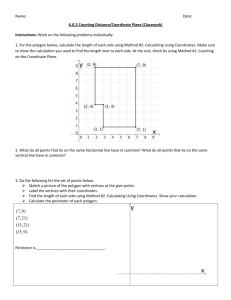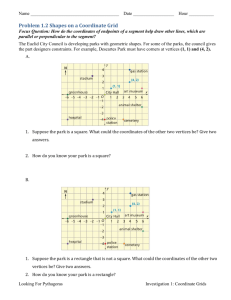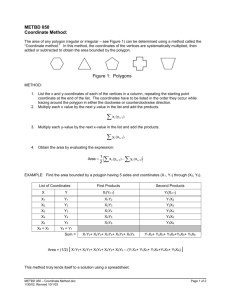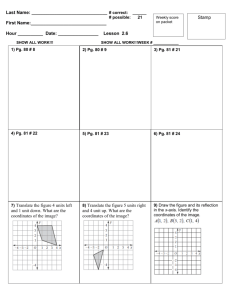6.G.3 Team Challenge #1 (+ Key) - Unit 5
advertisement
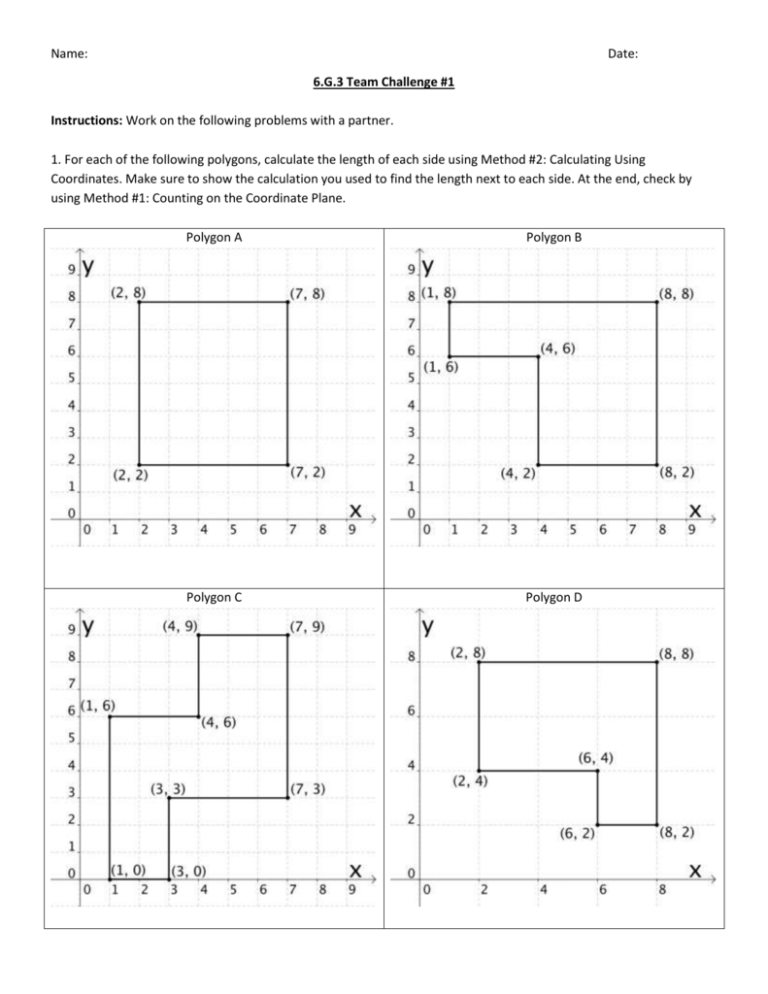
Name: Date: 6.G.3 Team Challenge #1 Instructions: Work on the following problems with a partner. 1. For each of the following polygons, calculate the length of each side using Method #2: Calculating Using Coordinates. Make sure to show the calculation you used to find the length next to each side. At the end, check by using Method #1: Counting on the Coordinate Plane. Polygon A Polygon B Polygon C Polygon D Name: Date: 2. Give the coordinates of three points that lie on a horizontal line with the point (–2, 7). Explain how you know that all three points lie on the same line with (–2,7). 3. Give the coordinates of three points that lie on a vertical line with the point (–2, 7). Explain how you know that all three points lie on the same line with (–2,7). 4. Given the two sets of coordinates below, which one defines a rectangle? Explain your reasoning. Note: Do NOT plot the points on the coordinate plane. Set A Set B (2,8) (3, 7) (3, 5) (3,10) (5,2) (7, 5) (4,1) (7,10) Name: Date: 5. Do the following for each set of points: Sketch a picture of the polygon with vertices at the give points. Label the vertices with their coordinates. Find the length of each side using Method #2: Calculating Using Coordinates. Show your calculation. Calculate the perimeter of each polygon. Note: The sketch with labeled vertices is provided for Set #1 as an example. The drawing does not need to be drawn to scale however points that lie on the same horizontal or vertical line must do so. Set #1 (3, 20) (3,15) (8,15) (8,20) Perimeter is _________________________________. Set #2 (7,15) (23,15) (23,2) (7, 2) Perimeter is _________________________________. Name: Date: Set #3 (1, 5) (1,12) (4,12) (4,10) (13,10) (13, 5) Perimeter is _________________________________. Set #4 (55,50) (55, 37) (15, 37) (15, 42) (28, 42) (28,50) Perimeter is _________________________________. 6. You are told that a rectangle has vertices at the following coordinates: (5,8) (87,8) (87,92) (5,92) To find the side lengths of the rectangle would you rather use Method #1: Counting on the Coordinate Plane or Method #2: Calculating Using Coordinates? Explain why you would use that method. (Note: you do not need to find the side lengths, just explain which strategy you would prefer and why) Name: Date: Challenge #1: For each of the following clues, find the 2nd endpoint of the line segment using your knowledge of coordinates, length and horizontal and vertical lines. Clues for Mystery Line Segment #1 Clues for Mystery Line Segment #2 I have one of my endpoints at (3,7). I have one of my endpoints at (12,19). I am a vertical line segment. I am a horizontal line segment. I am 3 units long. I am 10 units long. Where can my second endpoint be located? (There is more than one answer; can you find them all?) Where can my second endpoint be located? (There is more than one answer; can you find them all?) Challenge #2: For each of the following clues, find the missing vertex (or vertices) using your knowledge of coordinates, length and horizontal and vertical lines. Clues for Mystery Polygon #1 Clues for Mystery Polygon #2 I have one of my endpoints at (7,12). I have one endpoint at (8,8). I have another endpoint (2,5). I have a side length that is 3 units long. I am rectangle. I am a square. Where are my other vertices located? Where are my other three vertices located? (There is more than one answer; can you find them all?) Name: Date: 6.G.3 Team Challenge #1 (Answer Key) Instructions: Work on the following problems with a partner. 1. For each of the following polygons, calculate the length of each side using Method #2: Calculating Using Coordinates. Make sure to show the calculation you used to find the length next to each side. At the end, check by using Method #1: Counting on the Coordinate Plane. Polygon A Polygon B Polygon C Polygon D Name: Date: 2. Give the coordinates of three points that lie on a horizontal line with the point (–2, 7). Explain how you know that all three points lie on the same line with (–2,7). Any points that students come up with that have a 7 as the y-coordinate will work. The explanation should talk about how horizontal lines have the same y-coordinate because they are all the same distance away from the x-axis. 3. Give the coordinates of three points that lie on a vertical line with the point (–2, 7). Explain how you know that all three points lie on the same line with (–2,7). Any points that students come up with that have a –2 as the x-coordinate will work. The explanation should talk about how vertical lines have the same x-coordinate because they are all the same distance away from the y-axis. 4. Given the two sets of coordinates below, which one defines a rectangle? Explain your reasoning. Note: Do NOT plot the points on the coordinate plane. Set A Set B (2,8) (3, 7) (3, 5) (3,10) (5,2) (7, 5) (4,1) (7,10) Set B defines a rectangle because there are two sets of horizontal lines (two points have a y-coordinate of 5 and two points have one that is 10) and two sets of vertical lines (two points have a x-coordinate of 3 and two points have one that is 7). Name: Date: 5. Do the following for each set of points: Sketch a picture of the polygon with vertices at the give points. Label the vertices with their coordinates. Find the length of each side using Method #2: Calculating Using Coordinates. Show your calculation. Calculate the perimeter of each polygon. Note: The sketch with labeled vertices is provided for Set #1 as an example. The drawing does not need to be drawn to scale however points that lie on the same horizontal or vertical line must do so. Set #1 (3, 20) (3,15) (8,15) (8,20) Perimeter is 20 units. Set #2 (7,15) (23,15) (23,2) (7, 2) Perimeter is 58 units. Name: Date: Set #3 (1, 5) (1,12) (4,12) (4,10) (13,10) (13, 5) Perimeter is 38 units. Set #4 (55,50) (55, 37) (15, 37) (15, 42) (28, 42) (28,50) Perimeter is 106 units. 6. You are told that a rectangle has vertices at the following coordinates: (5,8) (87,8) (87,92) (5,92) To find the side lengths of the rectangle would you rather use Method #1: Counting on the Coordinate Plane or Method #2: Calculating Using Coordinates? Explain why you would use that method. (Note: you do not need to find the side lengths, just explain which strategy you would prefer and why) I would use Method #2. If I tried using Method #1, I would need to first plot the points on the coordinate plane and then count how many units long each side is. Because the numbers are big that would mean I would need to count A LOT of units! If I use Method #2 then I can just subtract coordinates once I figure out which ones horizontal or vertical to one another. Method #2 will be easier in this case. Name: Date: Challenge #1: For each of the following clues, find the 2nd endpoint of the line segment using your knowledge of coordinates, length and horizontal and vertical lines. Clues for Mystery Line Segment #1 Clues for Mystery Line Segment #2 I have one of my endpoints at (3,7). I have one of my endpoints at (12,19). I am a vertical line segment. I am a horizontal line segment. I am 3 units long. I am 10 units long. Where can my second endpoint be located? (There is more than one answer; can you find them all?) Where can my second endpoint be located? (There is more than one answer; can you find them all?) (3,10) or (3,4) (22,19) or (2,19) Challenge #2: For each of the following clues, find the missing vertex (or vertices) using your knowledge of coordinates, length and horizontal and vertical lines. Clues for Mystery Polygon #1 Clues for Mystery Polygon #2 I have one of my endpoints at (7,12). I have one endpoint at (8,8). I have another endpoint (2,5). I have a side length that is 3 units long. I am rectangle. I am a square. Where are my other vertices located? Where are my other three vertices located? (There is more than one answer; can you find them all?) (7,5) and (2,12) Teachers note: Other rectangles are possible if the two endpoints given in the clues are adjacent and not diagonal vertices on the rectangle. However such a case would lead to a rectangle with all slanted sides and this is unlikely to be given as a student’s first response. Four possible sets of points are possible. They include: A: (8,11), (11,11) and (11,8) B: (11,8), (11,5) and (8,5) C: (8,5), (5,5) and (5,8) D: (5,8), (5,11) and (8,11)
